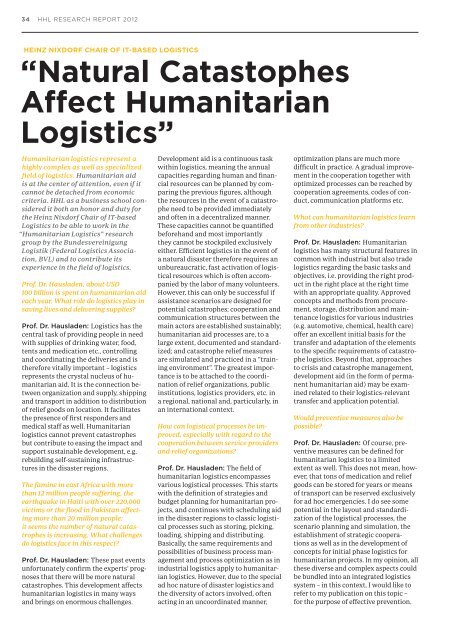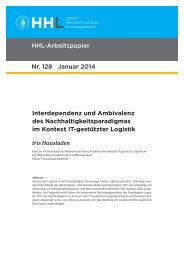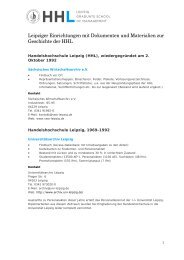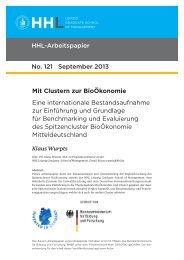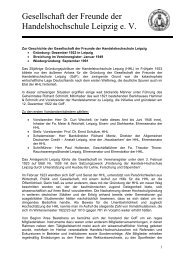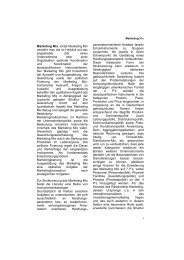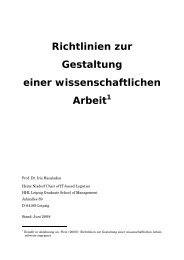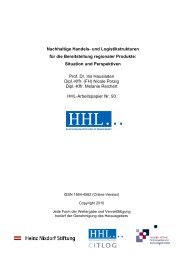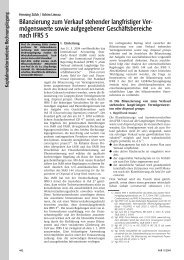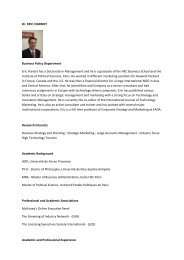Bio- and regenera- tive Medicine as an important growth Market
Bio- and regenera- tive Medicine as an important growth Market
Bio- and regenera- tive Medicine as an important growth Market
You also want an ePaper? Increase the reach of your titles
YUMPU automatically turns print PDFs into web optimized ePapers that Google loves.
34 HHL RESEARCH REPORT 2012<br />
HeinZ nixdorF cHair oF it-BaSed logiSticS<br />
“natural cat<strong>as</strong>tophes<br />
affect Hum<strong>an</strong>itari<strong>an</strong><br />
logistics”<br />
Hum<strong>an</strong>itari<strong>an</strong> logistics represent a<br />
highly complex <strong>as</strong> well <strong>as</strong> specialized<br />
field of logistics. Hum<strong>an</strong>itari<strong>an</strong> aid<br />
is at the center of attention, even if it<br />
c<strong>an</strong>not be detached from economic<br />
criteria. HHL <strong>as</strong> a business school considered<br />
it both <strong>an</strong> honor <strong><strong>an</strong>d</strong> duty for<br />
the Heinz Nixdorf Chair of IT-b<strong>as</strong>ed<br />
Logistics to be able to work in the<br />
“Hum<strong>an</strong>itari<strong>an</strong> Logistics” research<br />
group by the Bundes vereinigung<br />
Logistik (Federal Logistics Association,<br />
BVL) <strong><strong>an</strong>d</strong> to contribute its<br />
experience in the field of logistics.<br />
Prof. Dr. Hausladen, about USD<br />
100 billion is spent on hum<strong>an</strong>itari<strong>an</strong> aid<br />
each year. What role do logistics play in<br />
saving lives <strong><strong>an</strong>d</strong> delivering supplies?<br />
Prof. Dr. Hausladen: Logistics h<strong>as</strong> the<br />
central t<strong>as</strong>k of providing people in need<br />
with supplies of drinking water, food,<br />
tents <strong><strong>an</strong>d</strong> medication etc ., controlling<br />
<strong><strong>an</strong>d</strong> coordinating the delive ries <strong><strong>an</strong>d</strong> is<br />
therefore vitally import<strong>an</strong>t – logistics<br />
represents the crystal nucleus of hum<strong>an</strong>i<br />
tari<strong>an</strong> aid . It is the connection between<br />
org<strong>an</strong>ization <strong><strong>an</strong>d</strong> supply, shipping<br />
<strong><strong>an</strong>d</strong> tr<strong>an</strong>sport in addition to distribution<br />
of relief goods on location . It facilitates<br />
the presence of first responders <strong><strong>an</strong>d</strong><br />
medical staff <strong>as</strong> well . Hum<strong>an</strong>itari<strong>an</strong><br />
logistics c<strong>an</strong>not prevent cat<strong>as</strong>trophes<br />
but contribute to e<strong>as</strong>ing the impact <strong><strong>an</strong>d</strong><br />
support sustainable devel opment, e .g .<br />
rebuilding self-sustaining infr<strong>as</strong>tructures<br />
in the dis<strong>as</strong>ter regions .<br />
The famine in e<strong>as</strong>t Africa with more<br />
th<strong>an</strong> 12 million people suffering, the<br />
earthquake in Haiti with over 220,000<br />
victims or the flood in Pakist<strong>an</strong> affecting<br />
more th<strong>an</strong> 20 million people:<br />
it seems the number of natural cat<strong>as</strong>trophes<br />
is incre<strong>as</strong>ing. What challenges<br />
do logistics face in this respect?<br />
Prof. Dr. Hausladen: These p<strong>as</strong>t events<br />
unfortunately confirm the experts‘ prognoses<br />
that there will be more natural<br />
cat<strong>as</strong>trophes . This development affects<br />
hum<strong>an</strong>itari<strong>an</strong> logistics in m<strong>an</strong>y ways<br />
<strong><strong>an</strong>d</strong> brings on enormous challenges .<br />
Development aid is a continuous t<strong>as</strong>k<br />
within logistics, me<strong>an</strong>ing the <strong>an</strong>nual<br />
capacities regarding hum<strong>an</strong> <strong><strong>an</strong>d</strong> fin<strong>an</strong>cial<br />
resources c<strong>an</strong> be pl<strong>an</strong>ned by comparing<br />
the previous figures, although<br />
the resources in the event of a cat<strong>as</strong>trophe<br />
need to be provided immediately<br />
<strong><strong>an</strong>d</strong> often in a decentralized m<strong>an</strong>ner .<br />
These capacities c<strong>an</strong>not be qu<strong>an</strong>tified<br />
beforeh<strong><strong>an</strong>d</strong> <strong><strong>an</strong>d</strong> most import<strong>an</strong>tly<br />
they c<strong>an</strong>not be stockpiled exclusively<br />
either . Efficient logistics in the event of<br />
a natural dis<strong>as</strong>ter therefore requires <strong>an</strong><br />
unbureaucratic, f<strong>as</strong>t activation of logistical<br />
resources which is often accomp<strong>an</strong>ied<br />
by the labor of m<strong>an</strong>y volunteers .<br />
However, this c<strong>an</strong> only be successful if<br />
<strong>as</strong>sist<strong>an</strong>ce scenarios are designed for<br />
potential cat<strong>as</strong>trophes; cooperation <strong><strong>an</strong>d</strong><br />
communication structures between the<br />
main actors are established sustainably;<br />
hum<strong>an</strong>itari<strong>an</strong> aid processes are, to a<br />
large extent, documented <strong><strong>an</strong>d</strong> st<strong><strong>an</strong>d</strong>ardized;<br />
<strong><strong>an</strong>d</strong> cat<strong>as</strong>trophe relief me<strong>as</strong>ures<br />
are simulated <strong><strong>an</strong>d</strong> practiced in a “training<br />
environment” . The greatest import<strong>an</strong>ce<br />
is to be attached to the coordination<br />
of relief org<strong>an</strong>izations, public<br />
institutions, logistics providers, etc . in<br />
a regional, national <strong><strong>an</strong>d</strong>, particularly, in<br />
<strong>an</strong> international context .<br />
How c<strong>an</strong> logistical processes be improved,<br />
especially with regard to the<br />
cooperation between service providers<br />
<strong><strong>an</strong>d</strong> relief org<strong>an</strong>izations?<br />
Prof. Dr. Hausladen: The field of<br />
hum<strong>an</strong>itari<strong>an</strong> logistics encomp<strong>as</strong>ses<br />
various logistical processes . This starts<br />
with the definition of strategies <strong><strong>an</strong>d</strong><br />
budget pl<strong>an</strong>ning for hum<strong>an</strong>itari<strong>an</strong> projects,<br />
<strong><strong>an</strong>d</strong> continues with scheduling aid<br />
in the dis<strong>as</strong>ter regions to cl<strong>as</strong>sic logistical<br />
processes such <strong>as</strong> storing, picking,<br />
loading, shipping <strong><strong>an</strong>d</strong> distributing .<br />
B<strong>as</strong>ically, the same requirements <strong><strong>an</strong>d</strong><br />
possibilities of business process m<strong>an</strong>agement<br />
<strong><strong>an</strong>d</strong> process optimization <strong>as</strong> in<br />
industrial logistics apply to hum<strong>an</strong>itari<strong>an</strong><br />
logistics . However, due to the special<br />
ad hoc nature of dis<strong>as</strong>ter logistics <strong><strong>an</strong>d</strong><br />
the diversity of actors involved, often<br />
acting in <strong>an</strong> uncoordinated m<strong>an</strong>ner,<br />
optimization pl<strong>an</strong>s are much more<br />
difficult in practice . A gradual improvement<br />
in the cooperation together with<br />
optimized processes c<strong>an</strong> be reached by<br />
cooperation agreements, codes of conduct,<br />
communication platforms etc .<br />
What c<strong>an</strong> hum<strong>an</strong>itari<strong>an</strong> logistics learn<br />
from other industries?<br />
Prof. Dr. Hausladen: Hum<strong>an</strong>itari<strong>an</strong><br />
logis tics h<strong>as</strong> m<strong>an</strong>y structural features in<br />
common with industrial but also trade<br />
logistics regarding the b<strong>as</strong>ic t<strong>as</strong>ks <strong><strong>an</strong>d</strong><br />
objec<strong>tive</strong>s, i .e . providing the right product<br />
in the right place at the right time<br />
with <strong>an</strong> appropriate quality . Approved<br />
concepts <strong><strong>an</strong>d</strong> methods from procurement,<br />
storage, distribution <strong><strong>an</strong>d</strong> mainten<strong>an</strong>ce<br />
logistics for various industries<br />
(e .g . automo<strong>tive</strong>, chemical, health care)<br />
offer <strong>an</strong> excellent initial b<strong>as</strong>is for the<br />
tr<strong>an</strong>sfer <strong><strong>an</strong>d</strong> adaptation of the elements<br />
to the specific requirements of cat<strong>as</strong>trophe<br />
logistics . Beyond that, approaches<br />
to crisis <strong><strong>an</strong>d</strong> cat<strong>as</strong>trophe m<strong>an</strong>agement,<br />
development aid (in the form of perm<strong>an</strong>ent<br />
hum<strong>an</strong>itari<strong>an</strong> aid) may be examined<br />
related to their logistics-relev<strong>an</strong>t<br />
tr<strong>an</strong>sfer <strong><strong>an</strong>d</strong> application potential .<br />
Would preven<strong>tive</strong> me<strong>as</strong>ures also be<br />
possible?<br />
Prof. Dr. Hausladen: Of course, preven<strong>tive</strong><br />
me<strong>as</strong>ures c<strong>an</strong> be defined for<br />
hum<strong>an</strong>i tari<strong>an</strong> logistics to a limited<br />
extent <strong>as</strong> well . This does not me<strong>an</strong>, however,<br />
that tons of medication <strong><strong>an</strong>d</strong> relief<br />
goods c<strong>an</strong> be stored for years or me<strong>an</strong>s<br />
of tr<strong>an</strong>sport c<strong>an</strong> be reserved exclusively<br />
for ad hoc emergencies . I do see some<br />
potential in the layout <strong><strong>an</strong>d</strong> st<strong><strong>an</strong>d</strong>ardization<br />
of the logistical processes, the<br />
scenario pl<strong>an</strong>ning <strong><strong>an</strong>d</strong> simulation, the<br />
establishment of strategic cooperations<br />
<strong>as</strong> well <strong>as</strong> in the development of<br />
concepts for initial ph<strong>as</strong>e logistics for<br />
hum<strong>an</strong>itari<strong>an</strong> projects . In my opinion, all<br />
these diverse <strong><strong>an</strong>d</strong> complex <strong>as</strong>pects could<br />
be bundled into <strong>an</strong> integrated logistics<br />
system – in this context, I would like to<br />
refer to my publication on this topic –<br />
for the purpose of effec<strong>tive</strong> prevention .<br />
SuSTAinABiLiTY And COMPETiTivEnESS 35<br />
HHl wins national<br />
leading-edge cluster<br />
competition<br />
Together with about 40 partner<br />
comp<strong>an</strong>ies <strong><strong>an</strong>d</strong> half a dozen research<br />
institutions from Saxony-Anhalt<br />
<strong><strong>an</strong>d</strong> Saxony, HHL won the Leading-<br />
Edge Cluster Competition by the<br />
Federal Ministry of Education<br />
<strong><strong>an</strong>d</strong> Research (BMBF) with the<br />
“<strong>Bio</strong>Economy” project in early 2012 .<br />
The <strong>Bio</strong>Economy Cluster in central<br />
Germ<strong>an</strong>y, which will receive up to<br />
EUR 40m from the BMBF, focuses<br />
on the integrated material <strong><strong>an</strong>d</strong> energetic<br />
use of non-food biom<strong>as</strong>s for the<br />
production of materials, chemicals,<br />
energy carriers <strong><strong>an</strong>d</strong> products from<br />
new materials . Cross-cluster material<br />
flow m<strong>an</strong>agement <strong>as</strong> well <strong>as</strong> the<br />
development, scaling <strong><strong>an</strong>d</strong> implementation<br />
of production procedures by<br />
the industry allow for the optimization<br />
of value added from biom<strong>as</strong>s .<br />
With the support of the Helmholtz-<br />
Zentrum für Umweltforschung - UFZ,<br />
the Deutsches <strong>Bio</strong>m<strong>as</strong>seForschungs-<br />
Zentrum - DBFZ, <strong>as</strong> well <strong>as</strong><br />
InfraLeuna GmbH, HHL’s Heinz<br />
enzYMATIC<br />
HYDRolYSIS<br />
Nixdorf Chair of IT-b<strong>as</strong>ed Logistics,<br />
Stiftungsfonds Deutsche B<strong>an</strong>k Chair<br />
of Innovation M<strong>an</strong>agement <strong><strong>an</strong>d</strong><br />
Entrepreneurship along with the<br />
Chair of <strong>Market</strong>ing M<strong>an</strong>agement are<br />
responsible for the accomp<strong>an</strong>ying<br />
research within the cluster focusing<br />
on the development of competi<strong>tive</strong><br />
strategies <strong><strong>an</strong>d</strong> control tools .<br />
Specifically, HHL is involved in<br />
the projects of Material Flow<br />
M<strong>an</strong>agement, Innovation <strong><strong>an</strong>d</strong><br />
<strong>Market</strong>ing M<strong>an</strong>agement <strong>as</strong> well <strong>as</strong><br />
Govern<strong>an</strong>ce <strong><strong>an</strong>d</strong> Cluster M<strong>an</strong>agement .<br />
Prof . Dr . Iris Hausladen says on<br />
behalf of her HHL colleagues:<br />
“The project started on July 1, 2012<br />
with a consolidation of the experience<br />
of all partners involved in deliberations<br />
on the <strong>Bio</strong>Economy Cluster<br />
Strategy . The next concrete steps<br />
are the documentation <strong><strong>an</strong>d</strong> <strong>an</strong>alysis<br />
of established material flows <strong><strong>an</strong>d</strong><br />
their logistical concepts, <strong>an</strong> <strong>an</strong>alysis<br />
of the market, positioning, innovation<br />
<strong><strong>an</strong>d</strong> start-up potential <strong>as</strong> well<br />
WooD/BARK/ReSIDuAl MATeRIAlS<br />
AlCoHol-WATeR-PulPInG<br />
enzYMATIC<br />
HYDRolYSIS<br />
<strong>as</strong> the development of the tools of<br />
control for the cluster m<strong>an</strong>agement .<br />
Th<strong>an</strong>ks to the intensive practical<br />
collaboration with comp<strong>an</strong>ies from<br />
the cluster region <strong><strong>an</strong>d</strong> the interdisciplinary<br />
project approach at the<br />
interface of technology, economy<br />
<strong><strong>an</strong>d</strong> environment, the chairs involved<br />
in this project c<strong>an</strong> not only develop<br />
<strong><strong>an</strong>d</strong> tr<strong>an</strong>sfer methodological skills<br />
<strong><strong>an</strong>d</strong> experience in the highly innova<strong>tive</strong><br />
field of <strong>Bio</strong>Economy but also<br />
strengthen <strong><strong>an</strong>d</strong> exp<strong><strong>an</strong>d</strong> their position<br />
in the scientific l<strong><strong>an</strong>d</strong>scape .<br />
HHL is looking forward to the exciting<br />
collaboration between natural<br />
science <strong><strong>an</strong>d</strong> business practice . As<br />
the Germ<strong>an</strong> top m<strong>an</strong>ager Eberhard<br />
von Kuenheim once said: ‘Philosophy,<br />
technology <strong><strong>an</strong>d</strong> social sciences<br />
must meet more often . They should<br />
find a common l<strong>an</strong>guage .’ If you<br />
add economic sciences <strong>as</strong> a supplementary<br />
category to this list,<br />
the <strong>Bio</strong>Economy Leading-Edge<br />
Cluster is a wonderful example .”<br />
An example of a discussion subject within<br />
the <strong>Bio</strong>Economy Leading-Edge Cluster:<br />
the org<strong>an</strong>osolv pulping of wood <strong>as</strong> well <strong>as</strong><br />
possible applications of the products<br />
BASe-CATAlYzeD-<br />
DePolYMeRISATIon<br />
GluCoSe XYloSe PHenolS<br />
feRMenTATIon<br />
e.G. SuCCInIC ACID, lACTIC<br />
ACID foR BIoPlASTICS<br />
AlCoHol ReCYClInG<br />
CelluloSe HeMICelluloSe lIGnIn<br />
e.G. THeRMoSeTTInG<br />
MATeRIAl<br />
Source: ©Fraunhofer CBP


